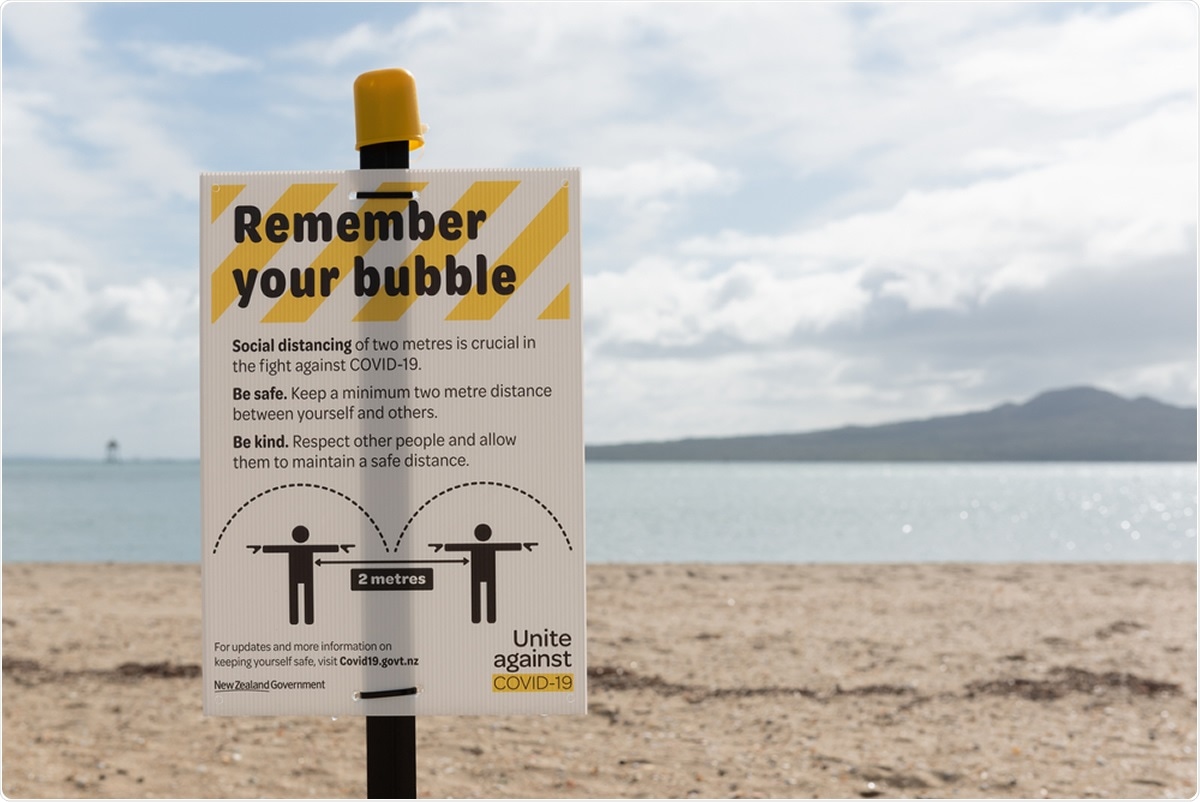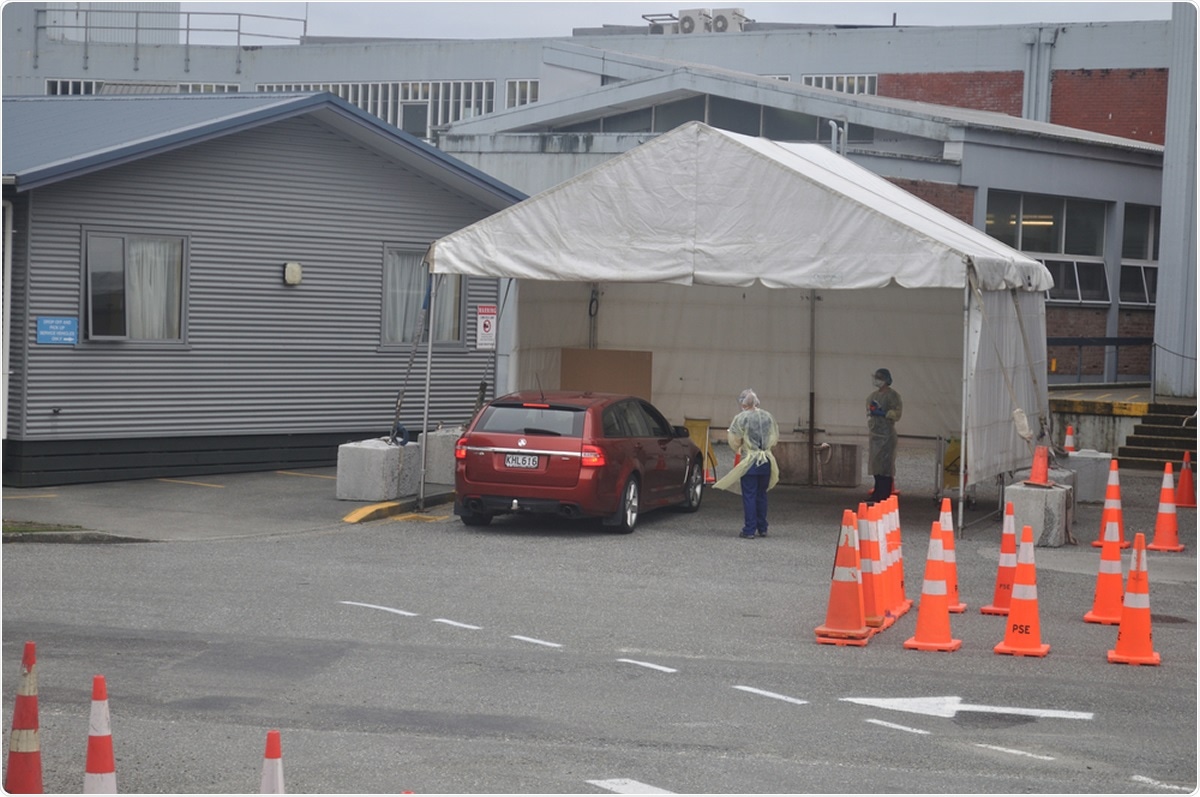Researchers from New Zealand have studied the epidemiological curve of the COVID-19 pandemic in their country. Their study titled "COVID-19 in New Zealand and the impact of the national response: a descriptive epidemiological study" was published on October 13, 2020, in The Lancet Public Health. This study was funded by the Ministry of Business Innovation and Employment Strategic Scientific Investment Fund and the Ministry of Health, New Zealand.

Mission Bay, Auckland / New Zealand - April 16 2020: Warning sign on Mission Bay beach reminding people to maintain 2 metres of social distancing during the coronavirus/covid-19 pandemic lockdown. Image Credit: Steve Todd / Shutterstock
Start of the pandemic and New Zealand
With the advent of the COVID-19 pandemic around the world, the New Zealand government started risk-informed national measures to suppress COVID-19. This study was conducted to see the effects of these measures on the first wave of the epidemic in the country.
The measures implemented that could stop the transmission of cOVID-19 include:
- Movement restrictions within the country and between nations
- The physical distancing between individuals to the tune of at least 6 feet and prevention of gatherings
- Hygiene practices including hand washing and wearing face covers such as masks
- Intensive case and contact detection and management that helps detect all cases of the infection and their isolation and quarantine to prevent them from spreading the infection to others
These measures were implanted early in China, Singapore, and South Korea. New Zealand, too moved early to adopt these measures to prevent the spread of the infection. The New Zealand Government aimed to stop the spread of the infection and to reach a very low or zero COVID-19 incidence. International travel was halted at the initial stages after the first case was confirmed on February 28, 2020. Within 26 days, a nationwide lockdown was put in place. This was a "stay-at-home order with few exemptions" of essential services.
New Zealand has a population of around 5 million people with 16 percent Indigenous Māori population, 7 percent Pacific peoples, 15 percent Asians, and 62 percent European or others.
Study design
This was a descriptive epidemiological study looking at all the laboratory-confirmed and probable cases of COVID-19 along with those who had been tested for the infection. Patients were included between February 2 and May 13, 2020. After this, the community transmission of the infection ceased in New Zealand. All measures taken to prevent the spread of the infection along with risk factors such as those leading to hospitalization or death were examined.
There were four alert levels for COVID-19 in the country along with non-pharmaceutical interventions and test and trace guidance. These were:
- Alert level 1
- Travel restrictions
- Case and contact management around the country
- Communication campaigns to promote hand and respiratory hygiene, isolation, and testing for symptomatic individuals
- Government COVID-19 income support and debt relief
- Alert level 2
- Physical distancing, especially for higher-risk groups (those over 70 years age)
- Prevention of large gatherings
- Permission for no more than 100 individuals for gatherings
- Alert level 3
- Stay within "bubbles" within household contacts, caregivers, etc.
- Encouraged to work-from-home
- Restrictions of face-to-face meetings
- Closure of public venues, gatherings (no more than 10 persons allowed)
- Telehealth services are encouraged
- Only essential inter-regional travel
- Alert level
- Stay at home encouraged
- Businesses unless essential services are closed
- Educational facilities and public venues closed
- Health-care services are reprioritized
- Promotion of public health campaign "Getting Through Together."
The progression of Alert level 1 to 4 was between March 21 and March 26, 2020. COVID suppression was divided into 5 phases:
- Phase 1 (Alert Level 1) - travel restrictions (February 2 to March 15, 2020)
- Phase 2 (Alert Levels 2 and 3) rapid escalation of non-pharmaceutical interventions (March 16tht to 25th)
- Phase 3 (Alert Level 4) – First half of lockdown between March 26 and April 10
- Phase 4 - Second half of lockdown, from April 11 to 27, 2020.
- Phase 5 – De-escalation to Alert Level 3 between April 28 and May 13, 2020. Alert Level 2 from May 14

GREYMOUTH, NEW ZEALAND; APRIL 11, 2020: A vehicle visits the Covid 19 testing station at Greymouth Base Hospital during the level 4 lockdown in New Zealand, April 11, 2020. Image Credit: Lakeview Images / Shutterstock
Results of the study
Overall findings of the study were:
- Over the study period, a total of 1,503 cases were detected
- Of these, 69 percent or 1,034 were imported from other countries
- Of these, 6.3 percent or 95 were hospitalized
- There were 1.5 percent or 22 deaths due to COVID-19
- The case infection rate per million people per day was highest at 8·5 during the 10-day period of rapid response escalation. It fell to the lowest of 3·2 at the start of lockdown and declined further.
- Most imported cases were younger adults and of European ethnicity and of higher socioeconomic status
- There were 34 recorded outbreaks, and 47 percent of these cases (34 cases) were responsible for these outbreaks
- Severe outcomes were seen with infections that were locally acquired compared to imported cases.
- Severe outcomes were associated with older age and those staying at aged residential care.
- Pacific peoples and Asian ethnicities were more likely to have severe outcomes compared to European or others.
- Over the study period, there was a decline in time between the onset of illness and notification and isolation. Rates of testing also rose steadily over the study period
- Coverage for testing was more for females, Māori, Pacific peoples, and lower socioeconomic groups.
Conclusions and implications
The authors concluded, "New Zealand's response resulted in the low relative burden of disease, low levels of population disease disparities, and the initial achievement of COVID-19 elimination." Border closures and effective non-pharmacological interventions helped New Zealand effectively control the pandemic spread, the authors wrote.
They wrote, "Integral to New Zealand's response has been decisive governance, effective communication, and high population compliance."
The team calls for more surveillance and research to understand the cost benefits of these measures.